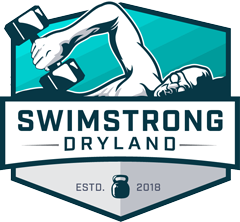The Necessity of Dryland Training
The benefits of a dryland program are overwhelming. Phase-by-phase dryland training, known formally as a periodized strength program, has three main benefits. It improves overall performance, aids in injury prevention, and exposes weaknesses. Let’s look at each of these individually to see how it applies to fast swimming.
Improves Overall Performance
As you would probably guess, dryland training increases both strength and power. In the water this translates to improvements in both your distance per stroke as well as your stroke rate. We all know the goal is to swim fast. But you can’t expect your times to drop without a strong and powerful pull! Then add in a high stroke rate with an efficient pull, and now you’ve really got something. Not to mention the incredible significance of powerful kicks, starts and turns. You need great leg strength to maintain your kicking cadence as well.
While the resistance of the water naturally develops some strength, eventually this resistance isn’t enough to continue seeing significant gains. Providing an external stimulus of professionally designed resistance training causes your body to grow and adapt, solving this problem.
Core development is also a crucial part of dryland training (and no, I don’t mean just focusing on getting a chiseled 6-pack). The core includes all of the major muscle groups that contribute to stabilizing the body and controlling its movements. Core strength is the key to positioning the stronger, more powerful movements in the water to keep every stroke aligned for maximum efficiency. Training the core on the land let’s us isolate muscle groups in different planes to identify weaknesses and make them strengths. When you have the endurance to control your core through every stroke, energy is focused on power and efficiency, and injury is prevented by avoiding positions that put unnecessary stress in the wrong places, which leads me to my next point.
Injury Prevention
Injuries are incredibly frustrating, especially when it comes to the competitive athlete. It prevents you from progressing and keeps you from competition, both of which are painful to endure (aside from the literal pain of the injury!). Dryland training plays a huge role in keeping the athlete strong and healthy. The most common injuries in swimming involve the shoulder complex, knees, and hips. Strengthening the posterior chain and core stabilization muscles through dryland training drastically reduces the chances of injury by providing a strong support for all of the rigorous and repetitive movements involved in swimming.
Swimmers in general face an overload of repetitive movement patterns. Without proper core strength, the strokes begin to fall apart. And if you don’t train your mind and body to understand which muscles are being engaged with each stroke, it’s easy to begin using the wrong muscles, especially once the athlete fatigues. For example, in the front crawl, with every stroke the lats fire and pull hard on the spine. If you haven’t trained to properly strengthen the muscles around your spine, then when the lats fire they can’t translate all of the pull like they should, and the result is that the shoulders take on the added stress. This added strain on the shoulders in a position they weren’t designed for can lead to chronic shoulder issues.
Exposes Weaknesses
Dryland training will teach you things about your body that you may never otherwise notice. For example, you may find you have better stability on one side of your body, which leads to greater muscle imbalances and increases your risk of injury. Once identified, you can focus your effort on specific exercises to improve this weakness and balance out your body. There are hundreds of examples like this that could be used to emphasize this point. Long story short…DO DRYLAND!!

